Easily Fix A Mountain Bike Chain That Won’t Shift To Low Gears
The chain, chainring, derailleur, and cassette make up the four essential bike components of the drivetrain. Without them, you cannot transfer power from the pedals to the wheel of your bike. It is important that you are able to use all of your bike’s gears so that you can get the most out of your bike. For this reason it is important that you fix any [problems such as a mountain bike chain that won’t shift to low gears.
To fix a mountain bike chain that won’t shift to low gears, put the bike on a stand, check the shifters, assess the derailleur for damage and debris, clean and lubricate all drivetrain parts, test the gears, and adjust the cable tension. Finally, check all gears again, and take the bike for a test ride.
A mountain bike chain that is not getting to the low gears can be a significant problem because it causes the chain to slip off the smallest ring in the front or the largest cog on the rear derailleur. This will make it impossible to shift to a low gear when climbing steep inclines. You will need to troubleshoot a few possible areas to determine why the chain isn’t shifting to the lowest gear.
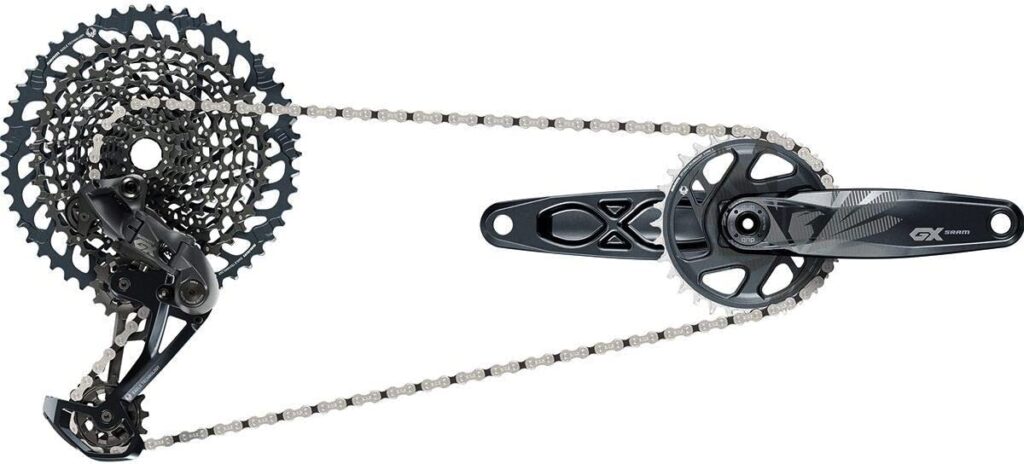
How Bike Gears Work
Bike gears refer to bike speeds that enable you to optimize for the most effective and comfortable rhythm and rate of pedaling. Each gear is associated with a specific sprocket on the bike cassette.
Bike gears work through levers on the handlebars that adjust the gear cable tension which then shifts the chain from cog to cog on the bike cassette, thereby altering the effort needed to cycle.
A high gear, or large gear is used when riding at high speeds or descending. To shift your bike to the highest gear, the chain must be shifted to the smallest cog on the bike cassette. A low gear, or easy gear, is used when riding at low speeds or pedaling uphill. To get your bike to the lowest gear, the chain must be shifted to the largest cog on the bike cassette. This post from Cycling weekly explains how bike gears work in greater detail.
Why Bike Gears Won’t Shift
Whenever you notice that your bike gears are not shifting properly, it means that one or more drivetrain components of the bike are faulty or have been damaged. The key to fixing your bike chain is to gain a better understanding of what is causing the problem.
Bike gears won’t shift because of derailleur damage, faulty cable tension, wrongly adjusted limit screws, too loose or too tight bike chain tension, debris on the derailleur, and shifter issues.
Fixing a gear shifting problem on your mountain bike could be as simple as cleaning and lubricating a chain as explained in our quick steps to clean a mountain bike chain and lube it or as complicated as having to fix a derailleur alignment issue. Our article that explains how to tighten a mountain bike chain derailleur will walk you through the various tweaks to make on a derailleur that is not fitted correctly to the bike. We will now proceed to describe each issue in detail so as to help you identify the problem.
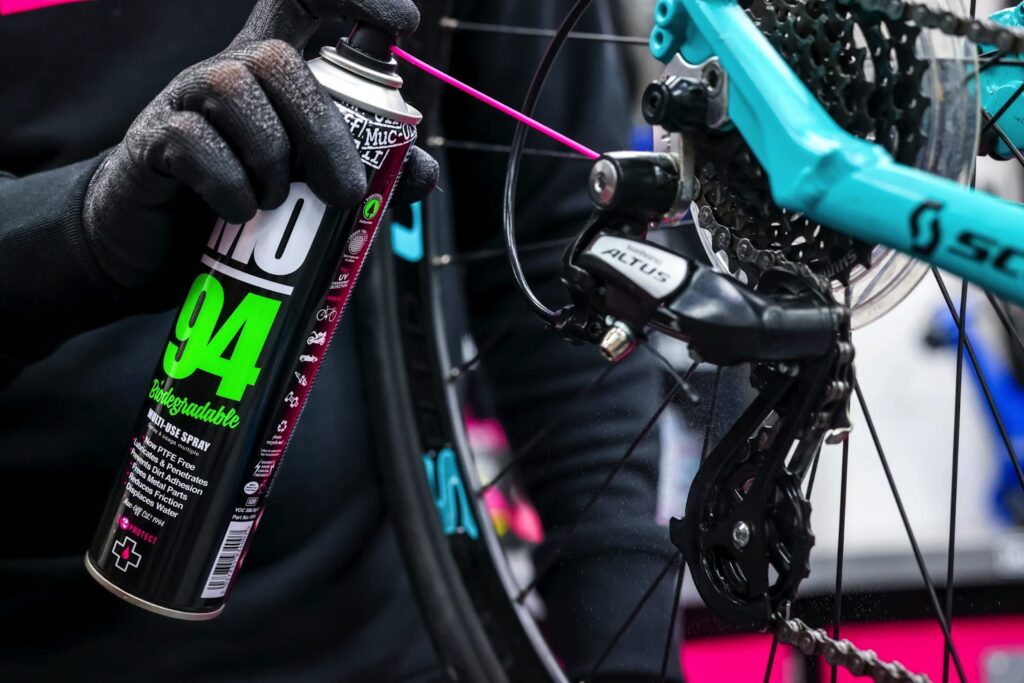
Here are the reasons why your mountain bike chain may not be shifting to low gears:
Reason 1. Rear Derailleur Not Shifting Down Properly
One reason for a mountain bike chain that won’t shift to low gears is a problem with the rear derailleur. Oftentimes, poor rear derailleur performance or a bent rear derailleur hanger prevents the chain from shifting gears properly. Checking the rear derailleur and hanger for damage is straightforward. First, make sure that the rear derailleur is compatible with other drivetrain components of the bike.
If the limit screws and the index settings are properly adjusted, check if the derailleur is worn in which case you can replace it with one like this, or the hanger is bent. The derailleur and derailleur hanger should be aligned with the bike cassette and chain. This video tutorial by Calvin Jones from Park Tool provides an advanced rear derailleur troubleshooting guide.
Reason 2. Cable Tension
Another possible reason your bike gears won’t shift properly could be cable tension that has not been adjusted correctly. Setting the tension of the cable that connects the rear derailleur to the shifter is essential to shift gears when riding. The cable should not be too tight or too loose.
If your bike chain is not shifting to low gear (or the largest sprocket on the cassette), then the cable may be too loose. Insufficient tension in your rear derailleur cable prevents the derailleur from moving, and therefore, the chain no longer shifts gears. This video tutorial by Brad Buccambuso explains how to adjust rear derailleur cable tension in a few easy steps.
Reason 3. Limit Screw Tightness
Every rear derailleur has two limit screws—one for the upper limit and the other for the lower limit. The upper limit screw is used for adjusting the distance the derailleur can move when shifting to higher gears. The lower limit screw is used for adjusting the distance the derailleur can shift to the lower gears.
If your bike gears do not shift down properly, you should check how tight or loose the limit screws are. Setting the L and H screw limits on your rear derailleur will ensure that the chain reaches all the gears without making any noise. This video tutorial by RJ The Bike Guy explains what derailleur limiting screws are and how to adjust them.
Reason 4. Bike Chain Tension
The tension of your bike chain is another factor that can and will affect the overall shifting performance of your bike. If the chain is too loose, it will most likely skip gears. If the chain is too tight, it may not be able to reach the low gear, which is the largest cog on the cassette.
The easiest way to tell if your bike chain is too tight to shift to the low gear is to check its movement. Ideally, a bike chain should move about ½ to 1 inch up and down.
You might also find interest in learning what to do if a mountain bike chain is too short. Be sure to read our related article to find out more.
Reason 5. Debris on Derailleur
Oftentimes, debris jamming the derailleur or other drivetrain components can cause bike gears not to shift. If your rear derailleur is too dirty, the overall shifting performance can be slowed down or the chain may no longer be able to reach the low gear. This is why you should keep your bike drivetrain as clean and as lubricated as possible. Our article about mountain bike chain lube alternatives will give you some unusual lube substitutes you can use if you’re out of lube.
Reason 6. Shifter Issues
If none of the above reasons seem to be relevant to your bike shifting issues, you should consider checking the shifter itself. Using damaged shifters can result in the bike chain landing on the wrong gear. This can be caused by a broken shifter or grease building up inside the shifter. RJ The Bike Guy offers a brief tutorial on troubleshooting bike shifters that will not shift gears. If your mountain bike grip shifter is stuck our article has some handy recommendations on ways to fix shifter issues.
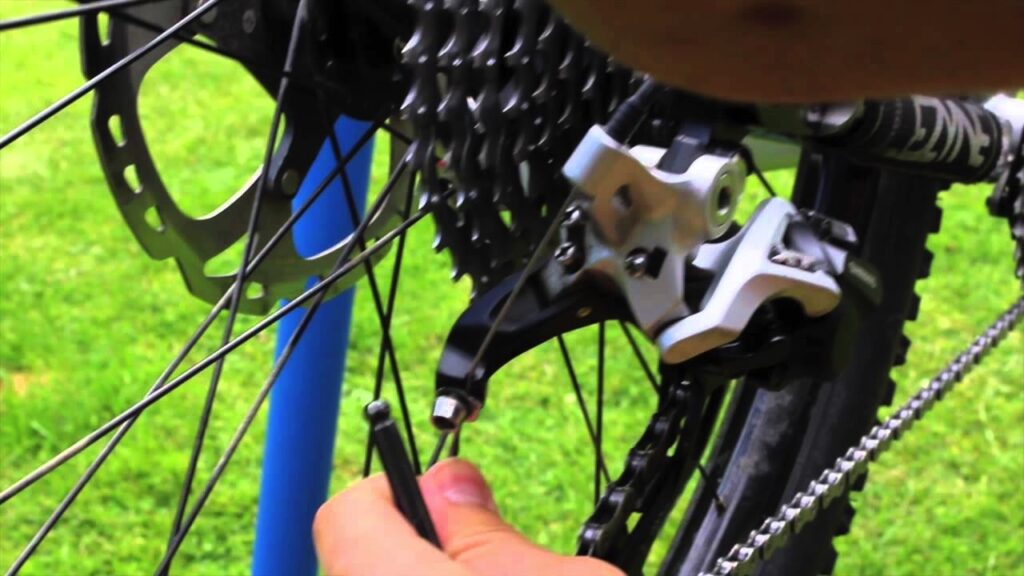
Materials to Fix a Mountain Bike Chain Not Shifting to a Low Gear
While fixing a mountain bike chain not shifting to a low gear might sound a bit challenging, the task is pretty straightforward. As long as you have the right tools, you can easily fix the problem.
The tools needed to fix a mountain bike chain that won’t shift to low gears include a bike stand, a rag, bike chain lubricant, screwdrivers, Allen keys, a bike chain tool, and a derailleur hanger alignment gauge.
Our ultimate list of tools for mountain bike maintenance will walk you through a list of the various tools that are available for mountain bike maintenance and what they are typically used for.
Bike Stand
Although it is optional to have a special bike repair stand like this, it will make things a lot easier. A bike stand suspends the bike frame so that all areas of the bike can be easily accessed. Alternatively, you can simply turn the bike upside down.
Rag
A rag will allow you to clean your bike chain and drivetrain parts. To do so, simply dampen the rag in hot water and wipe the chain, derailleur, cogs, and chainrings. Consider using a bike degreaser or soapy water for better results.
Bike Chain Lube
If the bike chain or other drivetrain parts are clogged with debris, you will need to lubricate the chain after thoroughly cleaning it. Lube should be selected based on the type of trails you ride most often. As our article about proper bike chain maintenance explains, wet lube should be used when riding on muddy and wet trails, and dry lube should be used when riding on dry and sandy trails.
Screwdriver and Allen Keys
When fixing a mountain bike chain that won’t shift to low gears, you may need to loosen or tighten screws and bolts. To do so, you should use a screwdriver and hex keys. However, you can also get a multi-tool like this instead.
Bike Chain Tool Kit
If your bike chain needs to be fixed or replaced to improve the overall shifting performance, you should consider using a bike chain tool and a pair of chain pliers from a kit like this. These will help easily break and reattach the individual chain links.
Derailleur Hanger Alignment Tool
If your rear derailleur hanger seems to be bent after a crash, you should align it again before it will be able to shift gears properly. While you can take your bike to a mechanic, you can also use an alignment tool like this to do it yourself.
| Item | Use | Amazon Link | Price |
| Bike Stand | To mount your bike and keep it steady while troubleshooting or fixing it. | Bike Repair Stand | ~ $85 |
| Rag | To wipe and clean bike drivetrain components. | Mr. Siga Microfiber Cleaning Cloth - Pack of 12 | ~ $20 |
| Bike Chain Lube | To lubricate the bike chain after cleaning it. | Finish Line 1-Step Cleaner and Lubricant | ~ $10 |
| Screwdriver | To loosen or tighten screws. | Klein Tools 11-in-1 Screwdriver | ~ $20 |
| Allen Keys | To adjust bolts. | Tekton Hex Key Wrench Set | ~ $25 |
| Multi-Tool | Used as an alternative for screwdrivers and Allen keys. | Crankbrothers M19 Multi-Tool + Case | ~ $35 |
| Bike Chain Tool Kit | To break the bike chain and reattach individual chain links. | Bike Link Plier + Chain Breaker Tool + Chain Checker | ~ $20 |
| Derailleur Hanger Alignment Tool | To align the bent rear derailleur hanger. | CycloSpirit Derailleur Hanger Alignment Gauge | ~ $50 |
How to Fix Bike Gears That Won’t Shift
Fixing a mountain bike chain that won’t shift to low gears will not always require visiting a bike shop. As long as you have the right tools and know how to troubleshoot your drivetrain isues, there is nothing to worry about.
To fix bike gears that won’t shift, first, mount the bike on a stand, check the drivetrain parts and the shifters for damage, then clean and lubricate the drivetrain components. Next test individual gears to find the problem, adjust derailleur cable tension, check all the gears once again, and take the bike for a test run.
Below are 10 easy steps to fix a bike with poor shifting performance.
Step 1. Place the Bike on a Stand
The first step is to mount the bike onto a repair stand like this. Limiting your mountain bike chain movement by keeping it in place will make it easier for you to access different parts of the bike. If you do not have access to a bike repair stand, turning it upside down to troubleshoot or fix the drivetrain is also an option.
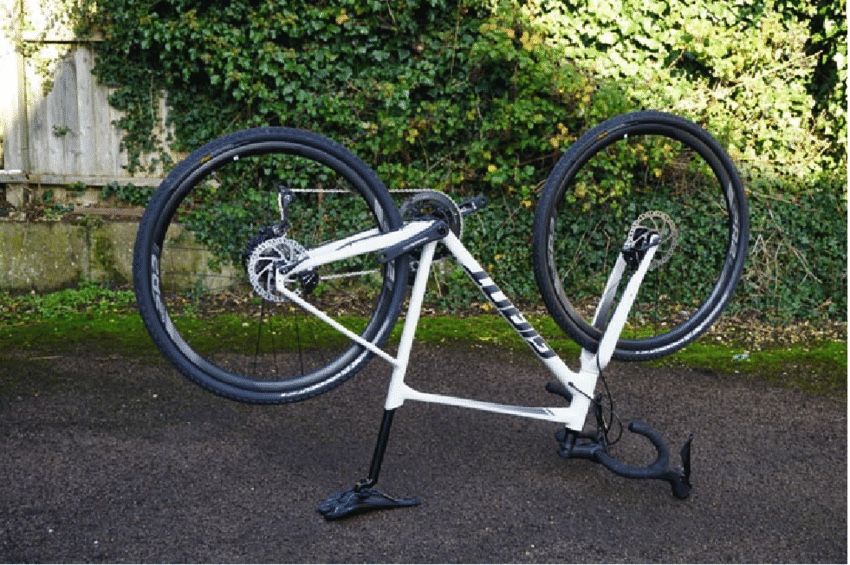
Step 2. Check Shifters
The next step is to check if your bike shifters are working properly. If the shifter is not catching or clicking, it means that it needs to be fixed or replaced with something like this. You should select the various gears to make sure they the chainrings engage correctly. If the shifters seem to be damaged, consider taking the bike to a mechanic to replace the shifters. This is easier and faster than replacing the shifters yourself. Read our article about how to fix mountain bike grip shifters for ways to fix them. Similarly, our article explaining how to replace a mountain bike chainring may also contain some useful information.
Step 3. Check Derailleur for Damage and Debris
If the shifters seem to be fine, consider checking the front and rear derailleur. You should look for any damage or debris jamming the drivetrain components. Our article about how to fix a bike chain that is rubbing on the front derailleur has tips to figure out whether the derailleur is damaged or simply dirty.
Oftentimes, shifting problems are caused by the front and rear derailleur or the derailleur hanger not being aligned properly. If you notice that the derailleur or the hanger is bent, consider using a derailleur hanger alignment tool. If you have noticed that your derailleur is dirty, consider cleaning it thoroughly using a kit like this to improve the overall shifting performance of the bike.
Step 4. Clean All Drivetrain Parts
Keeping your mountain bike drivetrain parts clean is fundamental to shifting gears properly. After each ride, consider using a rag to wipe away any debris. You should just damp a clean rag in some hot water, wrap it around the chain, and pedal manually. Gently wipe the derailleur, sprockets, and the chainwheel to clean them as well.
If the drivetrain components are too dirty to be cleaned with a simple wipe, use a bike chain and drivetrain cleaning kit like this for thorough cleaning.
Our article that explains how to fix a mountain bike chain that keeps breaking also has cleaning and lube tips to prevent this from happening.
If your drivetrain parts are clogged with debris, preventing the chain from shifting to low gear, use a damp rag to clean the components. Image Source: Cyclist.
Step 5. Lubricate Gears
If your mountain bike is still not shifting gears properly after cleaning the drivetrain parts, you should test each gear to determine the problem. You should first lubricate the gears with lube like this for the chain to run smoothly. As this article from the Journal of Mechanical Design explains, lubrication reduces friction and enhances chain efficiency. Add just a tiny amount of bike chain lube to the cogs, chain wheel, and chain before testing the gears.
Step 6. Test Each Gear
The next step is to test each gear, as this will allow you to find the problem. To do so, you should just shift the gears manually while pedaling and evaluate the shifting performance. This pedaling and shifting motion will also allow the lube that was applied in the previous step to penetrate and coat all parts of the chain and drivetrain.
Step 7. Identify the Problem Gear
The easiest way to identify the problem gear is by looking for chain slipping or skipping. If the chain is slipping over the gear, it means that the chain is too loose. Therefore, it is unable to reach the low gear. On the other hand, the chain might be stuck in the same gear because it is too tight to reach the next one. In both cases, you should adjust the chain so that it is neither too loose nor too tight. Our article that looks at whether your mountain bike chain is too long has helpful tips to calibrate your chain so that it can maintain optimal tension during gear shifts.
Step 8. Adjust Cable Tension
The next step is to adjust the cable tension by tightening the adjusters. To do so, shift the chain to the highest gear or the smallest sprocket on the cassette. Then, take a hex key and loosen the bolt that keeps your cable tight. After that, pull the slack to tighten the rear derailleur cable. Finish by securing the bolt, check if adjusting the cable tension solved the shifting problem.
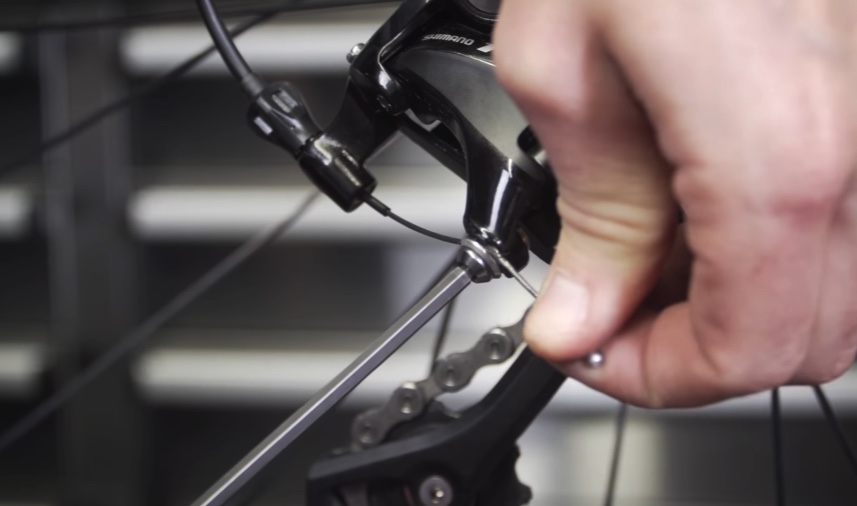
Step 9. Final Check of All the Gears
After adjusting the cable tension, you should do a final check of all the gears to ensure that the shifting problem has been solved. Do this by hand pedaling. Verify that the bike chain shifts to the lowest gear. Our article about how to fix a chain that keeps jumping gears or skipping has tips to help you ensure smooth gear changes, especially if you experience problems in the lowest gear.
Step 10. Take Your Bike for a Test Run
Taking your bike for a test ride is key to fixing a mountain bike chain that won't shift to low gears. It will help ensure that you will not face any shifting problems during an actual ride. A test ride can involve going for a simple ride around the block and changing through all the gears to ensure the shifting is smooth and consistent. If your MTB chain is shifting gears properly, rest assured that the problem is sorted out and enjoy the rest of the ride.
